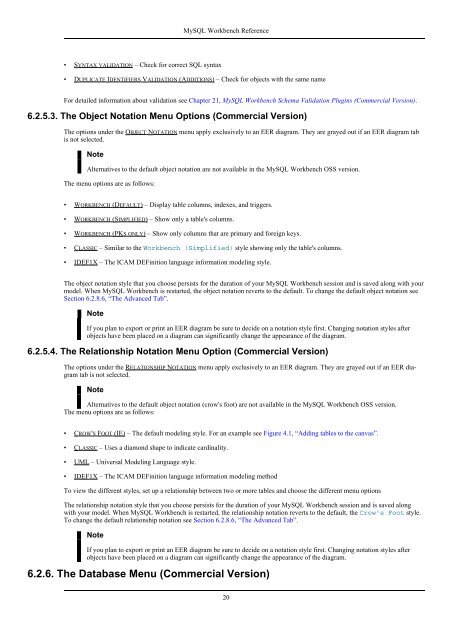workbench-en.a4
You also want an ePaper? Increase the reach of your titles
YUMPU automatically turns print PDFs into web optimized ePapers that Google loves.
MySQL Workb<strong>en</strong>ch Refer<strong>en</strong>ce<br />
• SYNTAX VALIDATION – Check for correct SQL syntax<br />
• DUPLICATE IDENTIFIERS VALIDATION (ADDITIONS) – Check for objects with the same name<br />
For detailed information about validation see Chapter 21, MySQL Workb<strong>en</strong>ch Schema Validation Plugins (Commercial Version).<br />
6.2.5.3. The Object Notation M<strong>en</strong>u Options (Commercial Version)<br />
The options under the OBJECT NOTATION m<strong>en</strong>u apply exclusively to an EER diagram. They are grayed out if an EER diagram tab<br />
is not selected.<br />
Note<br />
Alternatives to the default object notation are not available in the MySQL Workb<strong>en</strong>ch OSS version.<br />
The m<strong>en</strong>u options are as follows:<br />
• WORKBENCH (DEFAULT) – Display table columns, indexes, and triggers.<br />
• WORKBENCH (SIMPLIFIED) – Show only a table's columns.<br />
• WORKBENCH (PKS ONLY) – Show only columns that are primary and foreign keys.<br />
• CLASSIC – Similar to the Workb<strong>en</strong>ch (Simplified) style showing only the table's columns.<br />
• IDEF1X – The ICAM DEFinition language information modeling style.<br />
The object notation style that you choose persists for the duration of your MySQL Workb<strong>en</strong>ch session and is saved along with your<br />
model. Wh<strong>en</strong> MySQL Workb<strong>en</strong>ch is restarted, the object notation reverts to the default. To change the default object notation see<br />
Section 6.2.8.6, “The Advanced Tab”.<br />
Note<br />
If you plan to export or print an EER diagram be sure to decide on a notation style first. Changing notation styles after<br />
objects have be<strong>en</strong> placed on a diagram can significantly change the appearance of the diagram.<br />
6.2.5.4. The Relationship Notation M<strong>en</strong>u Option (Commercial Version)<br />
The options under the RELATIONSHIP NOTATION m<strong>en</strong>u apply exclusively to an EER diagram. They are grayed out if an EER diagram<br />
tab is not selected.<br />
Note<br />
Alternatives to the default object notation (crow's foot) are not available in the MySQL Workb<strong>en</strong>ch OSS version.<br />
The m<strong>en</strong>u options are as follows:<br />
• CROW'S FOOT (IE) – The default modeling style. For an example see Figure 4.1, “Adding tables to the canvas”.<br />
• CLASSIC – Uses a diamond shape to indicate cardinality.<br />
• UML – Universal Modeling Language style.<br />
• IDEF1X – The ICAM DEFinition language information modeling method<br />
To view the differ<strong>en</strong>t styles, set up a relationship betwe<strong>en</strong> two or more tables and choose the differ<strong>en</strong>t m<strong>en</strong>u options<br />
The relationship notation style that you choose persists for the duration of your MySQL Workb<strong>en</strong>ch session and is saved along<br />
with your model. Wh<strong>en</strong> MySQL Workb<strong>en</strong>ch is restarted, the relationship notation reverts to the default, the Crow's Foot style.<br />
To change the default relationship notation see Section 6.2.8.6, “The Advanced Tab”.<br />
Note<br />
If you plan to export or print an EER diagram be sure to decide on a notation style first. Changing notation styles after<br />
objects have be<strong>en</strong> placed on a diagram can significantly change the appearance of the diagram.<br />
6.2.6. The Database M<strong>en</strong>u (Commercial Version)<br />
20



